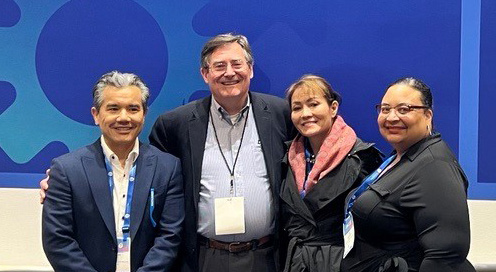The Cumulative Effect of Rural Residence, Mental Health Care Disparities and Communities of Color
By Fátima Reynolds, M.P.H.
“Don’t sleep on a rural setting.” This poignant comment came from an audience member at the 2023 APA Annual Meeting session, “The Cumulative Effect of Rural Residence, Mental Health Care Disparities and Communities of Color.”

The audience member was referring to the opportunities that exist for clinicians in American’s rural landscapes. According to Dr. Larry Merkel, the sessions’ chair and the chair of APA’s Rural Psychiatrists Caucus, rural America comprises 97% of U.S. topography, yet only 18% of its population.
“Rural areas are incredibly diverse in character, culture, geography, and wealth” he said. He explained they possess a resilience rooted in their cultural norms, like the hosting of pow wows within Indigenous communities, and these strengths exist in parallel to complex vulnerabilities. Pervasive issues impacting mental health for rural populations include decreased access to and availability of services and infrastructure, including lack of housing, jobs and education.
“We are talking about a poor and endangered population,” said Merkel.
The town of Pine Ridge, South Dakota embodies this distress. Panelist Dr. Dia Arpon shared that in Pine Ridge: 97% of the population lives below the poverty line the death rate is 300% higher than the general U.S. population; An average of 17 people live in a single-family home; and 33% of homes do not have electricity or water. She says the problem lies in the allocation of resources. Dr. Arpon provided snapshots of other rural areas around the country including Havre, Montana, Snow Hill, Maryland, and Wausau, Wisconsin. She depicted the diversity of each and underlined the importance of learning from rural areas and our own implicit biases.
Panelist Dr. Bernardo Ng echoed this sentiment, asserting that meeting the needs of rural populations, especially those with predominant communities of color, requires culturally sensitive providers and clinicians. He said these practitioners need data with diverse participants. According to Dr. Ng, African Americans and Hispanics/Latinos comprise less than 10% of scientific study participants. In the case of Alzheimer’s, Hispanics/Latinos comprise less than 1% of study participants despite being the largest minority in the country.
Robust inclusive data and collaborations between public, private and academic institutions are the way forward to address the rural mental health care crisis, said Dr. Ng. While similar risks (poverty, unemployment, lack of services, etc.) are shared among different rural areas, each setting possesses a unique history that comes to bear on the present state of health among its populace, as is the case in Hawaii.
Dr. H.K. Blaisdell-Brennan discussed peril of Native Hawaiians who had their way of life upended after western contact in 1778. Following population decimation from infectious disease, foreign exploitation, and cultural conflict that continues to this day, Native Hawaiians, which once numbered over one million, now number only 40,000 or 20% of Hawaii’s population.
Rural areas of Hawaii demonstrate a higher prevalence of mental health and substance use disorders, including higher suicide rates, when compared to state-wide and national averages. Dr. Blaisdell also shared that methamphetamine use had become a severe problem; there are more overdose deaths from methamphetamine than opioids.
She said advocacy plays a critical role in improving the quality and capacity of rural health services and called on psychiatrists to reclaim their seat at the table which, in some cases, has been occupied by public health professionals, social workers and others. Above all, she said, it is important for psychiatrists in rural settings to take care of themselves so they can best serve their patients. “Doctor, heal thyself,” she said.
